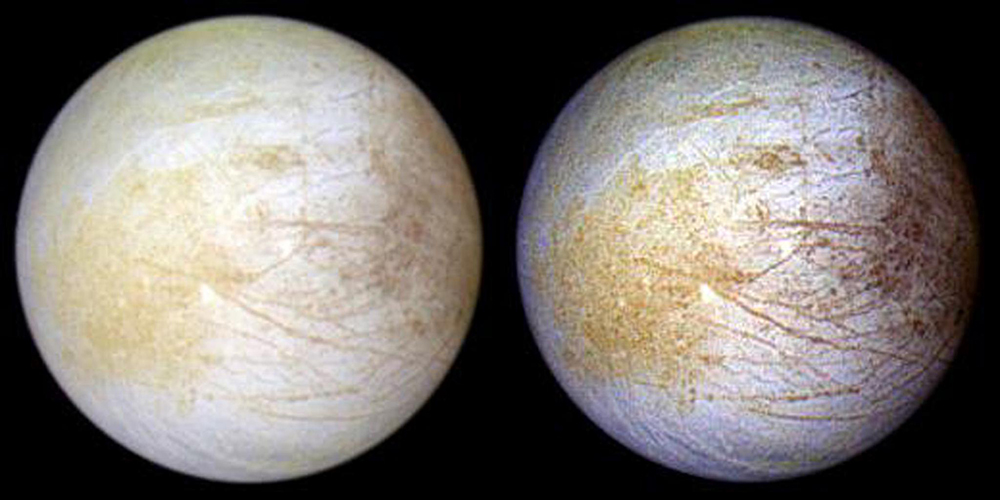New research involving the analysis of spectra obtained from the Hubble Space Telescope has revealed that the vast, yellow patches on the surface of Jupiter's moon Europa are made of table salt, NaCl. The results, which overturn a prevailing view of the moon’s salts as magnesium sulfates, offer new insights into Europan chemistry. Among the most intriguing is that Europa's vast subsurface ocean could be more similar to earthly oceans than previously thought, boosting the moon's odds as a place where alien life has emerged. See also: Astrobiology; Jupiter; Salt (chemistry)

A common mineral on Earth, table salt—technically sodium chloride—is the primary component in sea salt dissolved in our planet's oceans. Astronomers have long hoped to glean clues about the chemistry of Europa’s hidden liquid zone by studying its surface, because cracks in this moon's icy crust might allow the clandestine ocean's contents to spill into view. Salt-rich regions on Europa's surface are indeed located in geologically active “chaos terrain,” lending support to that hopeful conjecture. See also: Ocean
That such a familiar mineral in significant abundance would have gone undetected until now owes to particulars of table salt as well as to instrumentation used to historically study Europa. In the late 1990s, the Galileo spacecraft scanned Europa with an infrared spectrometer. The approach made scientific sense, because most minerals have characteristic signatures in infrared light. But sodium chloride is an exception. So, while the Galileo orbiter picked up magnesium sulfate salt readings among many other mineral identifications, the orbiter simply could not "see" sodium chloride. See also: Astronomical spectroscopy; Galileo mission; Infrared astronomy; Infrared radiation; Infrared spectroscopy; Mineral
The case for pervasive magnesium sulfate salts weakened in 2016, when the salts did not appear in expected locations during high-resolution infrared observations of the moon by the W. M. Keck Observatory in Hawaii. That finding tied into experimental results published the year prior. Researchers found that when sodium chloride is irradiated, just as it would be if on Europa's surface, the salt takes on a yellowish tint, matching the Jupiterian moon's complexion. To settle the matter, the Hubble Space Telescope performed visible light spectroscopy on Europa. Sure enough, the orbiting space observatory found clear signatures of irradiated table salt. See also: Astronomical observatory; Hubble Space Telescope; Spectroscopy
The nature of the ocean from which the saltyliquid likely issued forth still remains mostly unknown. Scientists first suspected that ocean’s existence in 1979, based on initial pictures sent by the Voyager 2 probe. Long linear features on Europa's surface were not well-explained by tidal (gravitational) interactions with its mammoth host, Jupiter, instead pointing to a crust in motion upon a fluid interior. The Galileo spacecraft later registered changes in Jupiter's magnetic field at Europa, consistent with the moon possessing an electrically conductive, internal, salty ocean. With that chemistry now trending closer to Earth's chemistry, coupled with potentially life-enabling heat and energy sources—for instance, from radioactive decay and tidal interactions—the level of interest in Europa's insides will only grow. The wait will not be long. In the 2020s, NASA plans to send a dedicated spacecraft mission, the Europa Clipper, to observe the world in unprecedented detail. See also: Conduction (electricity); Radioactive minerals; Tide





